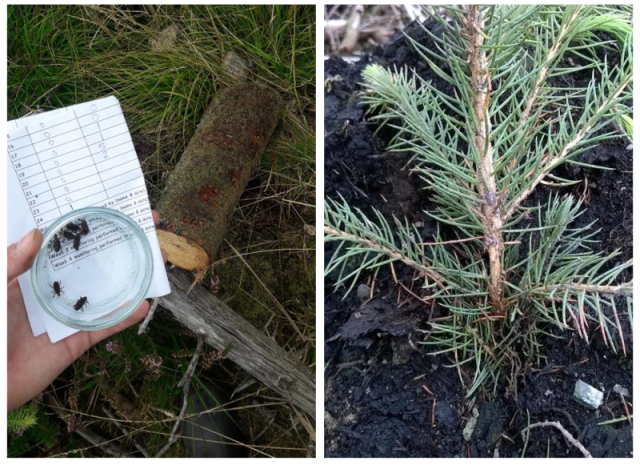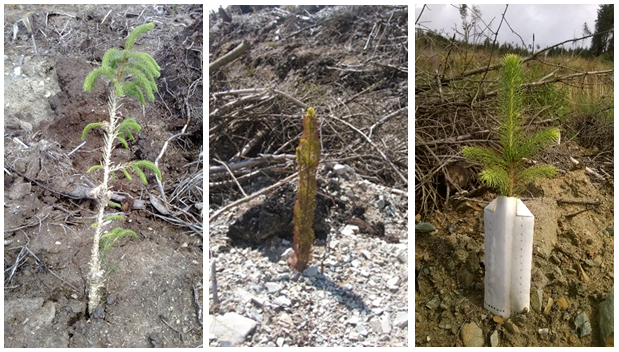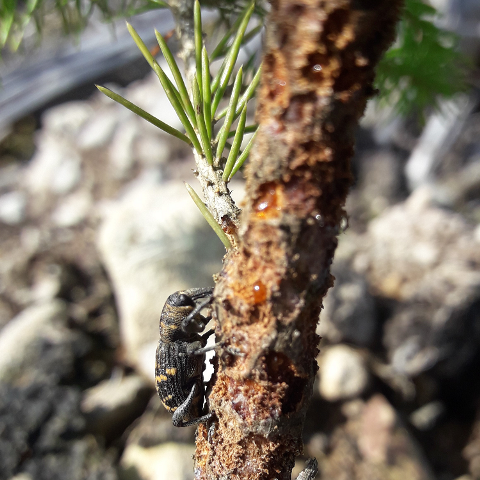Large Pine Weevil: The small pest causing a big problem for restocking
5 May 2020Hylobius abietis, commonly referred to as the large pine weevil, is regarded as one of the biggest threats to newly planted trees on restock sites.
Conservative estimates suggest that the direct cost of Hylobius damage to forest owners in the UK is in the region of £5 million per annum.
Conifer restock sites provide the optimum habitat for Hylobius, as they support all stages of the lifecycle. When the trees are cut down they release volatile organic compounds which attract adult Hylobius. The conifer stumps provide suitable areas to lay eggs and for the larvae to mature to adulthood. A new generation of adults emerge from the stumps in late summer and feed on newly planted saplings.
Adult Hylobius feed on the phloem, cambium and bark of saplings and will kill trees if they strip all the bark around the stem, known as girdling. Although this article concentrates on the impact of Hylobius on conifer restocking it is important to acknowledge that Hylobius feeding is non-specific, and they will also feed on broadleaves and mature trees if coniferous food sources are not available.
Hylobius will feed at any time of year when the temperature is warm enough but, as a general rule, are active between early March and November. There are two peak times when feeding damage is very high: one in spring before the migrating adults lay eggs and one in late summer when new adults emerge from stumps.
Because conifer restock sites provide the optimum habitat for Hylobius they can support very large populations which, if left uncontrolled, can result in entire restock crops being wiped out. When feeding damage is moderate and the tree is not killed the damage still has an impact on crop quality, causing poor stem form and reduced growth, which may have an economic impact at harvest. Thus, it is important to effectively control Hylobius populations and limit the level of damage they cause.
Alternative silvicultural systems
Before large scale clear-felling and restocking programmes became commonplace, low numbers of Hylobius existed in woodlands, relying on individual tree deaths for breeding and egg-laying sites. This limited availability of suitable sites controlled population size. The rise in the number of commercial clear-fell and restock sites Hylobius has been provided with an abundance of suitable breeding sites and food provision to support large populations with the ability to cause severe damage to restock saplings. Alternative silvicultural systems to clear-fell, such as continuous cover forestry, avoid large areas of trees all being felled at once. This could reduce Hylobius populations by limiting the number of stumps suitable for egg-laying at any given time. However, the move away from clear-fell to continuous cover systems is not always economically or practically viable and usually can’t be considered as a Hylobius control method alone.
Fallow period
After clear-felling, sites can remain susceptible to Hylobius damage for a number of years. Waiting 2 to 4 years before replanting can allow the population to decline and adults to disperse, but it is important to note that felling permission usually requires sites to be restocked within 3 years of felling. Leaving sites fallow for a number of years can dramatically reduce the level of damage to saplings but leaving sites fallow can result in substantial weed growth, requiring more herbicides, which has both environmental and economic implications. It also must be acknowledged that leaving a site fallow, lengthens the rotation time and increase the time until the next harvest and timber income.
Integrated pest management
Integrated pest management focuses on using non-chemical control options instead of, or in combination with, chemical controls rather than relying exclusively on chemicals as a first response to pests. This may be simply planting larger, more robust trees that are better able to resist weevil attack and competition from weeds and can include decision support tools such as Forest Research’s Hylobius Management Support System. Forest managers can monitor the abundance of weevils on-site and the software uses this data to predict if damage is likely, and what treatment is recommended.
Biological controls
Parasitic nematodes (Steinernema carpocapsae) can be applied to stumps to kill Hylobius larvae. This reduces the number of adults that emerge, and subsequently the level of damage to saplings and the number of adults migrating to new sites. Application requires large volumes of water and specialised equipment to be fixed to forwarders. This can make the use of nematodes impractical and expensive in remote locations or where ground conditions prevent forwarders being used.
Physical protection
Tree shelters can help to protect against Hylobius damage but using them exclusively for large-scale weevil protection is expensive. To date, a number of physical protection methods developed specifically for Hylobius protection have been tried. These include waxed paper sleeves, plastic sleeves and various polymer and wax coatings sprayed directly onto the trees. Some of these methods have been successful in Scandinavia, but trials in the UK, where Hylobius populations are significantly higher, have found them to be effective only if onsite populations are low.
Insecticides
Even when using a combination of non-chemical methods it is often not possible to avoid Hylobius damage. When there are no practical alternatives, the only remaining option is to use insecticides. Currently, the main insecticide used is acetamiprid, which can be applied to trees at the nursery so that saplings are protected as soon as they are planted. Trees may need to be re-sprayed post-planting when weevil populations are high.
It is quite likely that the use of acetamiprid may become more restricted in the future. Without effective alternative weevil control options, it may become economically unviable to restock some areas after harvesting, crop quality will be adversely affected and future timber availability will be reduced. It is critical that we develop alternative methods to control weevil damage, ideally not reliant on insecticides. For the past 11 years Tilhill, in partnership with Maelor Forest Nurseries Ltd, Cumbria University, Scottish Woodlands and, historically, the Forestry Commission and Forest Research, has been involved in trials to find such alternatives.
The trials have focussed on chemical, physical and biological control methods, testing 150 combinations of different products including physical and biological controls, different application rates and application methods. To date, acetamiprid (an insecticide) has proved most effective, but recent trials have placed more focus on trialling biological controls, repellents and physical coatings and barriers, including Neem extracts, waxed paper sleeves and various polymer and wax coatings sprayed directly onto the trees. Different types of coatings have been trialled, sometimes with adjuvants included, different coagulants used or with abrasive elements, such as quartz, mixed through.
Tilhill is also a partner of the Hylobius Industry Research Programme, along with others from the private and public sectors, including Forest Research, Forestry England, Forest and Land Scotland, Natural Resources Wales, Coillte, Northern Ireland Forest Service, Confor, Scottish Woodlands and the forestry nurseries Maelor Forest Nurseries Ltd, Trees Please and Christie Elite. The partnership has identified five priorities to address the threat of Hylobius:
- To develop alternatives to chemicals that work in areas of high Hylobius population, including physical barrier products.
- Develop a viable biocontrol option, using insect pathogenic organisms such as fungi and nematodes that prey on and kill Hylobius.
- Identify a range of alternative, weather-resistant, non-neonicotinoid pesticides that have low environmental impact and that might be used as a last resort if other methods of non-chemical protection fail.
- Develop an improved predictive Hylobius population model, appropriate for use in all situations.
- Create a regularly updated guide on Hylobius integrated pest management for use by all stakeholders across the sector.
The estimated cost of achieving these priorities is approximately £2 million. The Scottish Government has already made available £550,000 from the ‘Can Do’ Innovation Fund, but support is still needed. The partnership is appealing to corporate supporters across the forestry sector, concerned individuals, private charitable trusts and various research bodies for grants for additional funding.
For advice on Hylobius management on restock sites, call the FAS helpline on 0300 323 0161 or email advice@fas.scot
Cat Kent, Technical Champion – Weevils and Assistant Forest Manager, Tilhill for the Farm Advisory Service
Sign up to the FAS newsletter
Receive updates on news, events and publications from Scotland’s Farm Advisory Service



